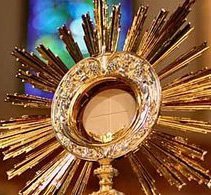
But today is also the Feast Day of Thomas Becket, Archbishop of Canterbury. It has been omitted this year because of the transfer of the Holy Innocents. I do not want to forget Thomas this year, though.
For most of my life, I didn't think much about him. That changed a couple of years ago when I spent the summer in the United Kingdom. As part of my sojourn there, I made the obligatory pilgrimage to Canterbury Cathedral. As cathedrals go, it's not much, in my opinion. There are so many more beautiful cathedral, particularly at Petesrburgh.
As I was wandering about after the principal Eucharist that Sunday, I walked though a passage and ran smack dab into Thomas' death site. I hadn't even thought of him on the way to the cathedral or while in the cathedral. But there it was.
My whole body stopped moving as if I'd been physically restrained and shoved backwards. Although I'd looked at the Martyrs' monument in Oxford, this was different. Oxford was much changed since the burning days.
But here, it was exactly the same as it was on this day in 1170! There they were-- the actual stones his blood ran over. In that instant history and faith were one for me. I stood there in stunned silence because I understood the power that martyrdom has.
I was alone there at the spot for a few minutes before other people, who knew the spot and had come specifically to see it, arrived. One visitor was a history "don" (a head, fellow, or tutor of a college) from Cambridge. He stood there for a minute then looked at me and said, "I had the same reaction; it's really remarkable, isn't it."
As we talked (history major to history major) he filled me in on many interesting things about Thomas (including a possible/probably romantic link between Henry and Thomas) and the site. One of the things he said was, "If you reacted thusly to this, can you imagine the reaction of the pilgrims 900 years ago when they saw the shrine?" My reply was so inadequate, "no, I can't!"
He took me up the stairs that Thomas had taken his last steps, and once in the great Choir he showed me where the shrine stood and pointed to a candle burning in the center of the floor. He explained that the candle burns continually and marks the spot where Thomas' body lay in the shrine.
Then he took me back down the stairs and showed me a little chapel to the side of the spot of martyrdom. He explained that many "competent" historians believe Thomas is burred in the chapel. When Henry VIII sent his men to loot the shrine and dispose of the body, the monks apparently secreted Thomas away and buried him in this chapel and put some other unfortunate person's bones in the shrine and it was the "fake" Thomas who was disposed of.
He told me of "odd" services held throughout the centuries in the chapel on St. Thomas' day, and other interesting bits that lead the experts to believe the events transpired as he told me they had.
But, in the end, it was the power of the spot that captivated me; and continues to captivate me. I understand the power of the martyrs now. I'll never be able to sing the Te Deum without realizing that power in the phrase "The Noble Army of Martyrs praise thee...."
O God, our strength and our salvation, you called your servant Thomas Becket to be a shepherd of your people and a defender of your Church: Keep your household from all evil and raise up among us faithful pastors and leaders who are wise in the ways of the Gospel; through Jesus Christ the shepherd of our souls, who lives and reigns with you and the Holy Spirit, one God, for ever and ever. Amen.Here's a bit of trivia for you: The same day same three knights of King Henry killed a baker and his family after the king stated that he'd kill for a good meat pie. Say a prayer for the baker and his family, too.
.jpg)






|